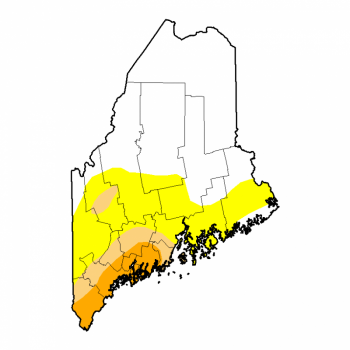State Drought Task Force reports worsening conditions with three-year dry streak
The State's Drought Task Force held its second 2016 meeting Sept. 8 to discuss current drought conditions across the state. The DTF assists in monitoring, coordinating, and managing responses to droughts and recommends actions to minimize impacts to public health, safety, the environment and agriculture.
"As we heard today, this drought has been building for about three years and it's not going to go away overnight," said Bruce Fitzgerald, Director of Maine Emergency Management Agency, in a news release. "The southern portion of the state continues to be the most severely affected and severe drought conditions are now expected to reach as far as Wiscasset."
See the U.S. drought monitor for updated information. According to that federal resource: “short-term precipitation deficits (30–60 day), low streamflows, and dry soils led to the expansion of areas of Extreme Drought (D3) in the Finger Lakes District of New York as well as in southeastern New Hampshire. In Maine, short-term precipitation deficits (4–10 inches during the past 90 days) and low streamflows led to the expansion of areas of Moderate Drought (D1) and Severe Drought (D2) along the coast. During the past week, the Northeast remained in an overall dry pattern with no significant rainfall accumulations observed across the majority of the region. Average temperatures were one-to-five degrees above normal across the much of the region with the greatest temperature anomalies observed in northern Maine.
The National Weather Service reported that northern Maine is above average with precipitation, but most other counties are seeing a deficit, which could improve with increased rainfall in the fall. For the next few weeks, however, temperatures are expected to be above normal with below-normal levels of precipitation, the release said.
The U.S. Geological Survey reported that groundwater basins in northern Maine are at normal or close to normal levels.
Those in the southern and Down East portions of the state are continuing to drop and are low or very low.
"Groundwater levels in Sanford and Poland are the lowest on record for the months of July and August, going back 15-30 years" said Nicholas Stasulis, Data Section Chief, U.S. Geological Survey. "Surface water conditions are generally below normal to a moderate hydrologic drought for the southern two-thirds of the state."
Representatives from the Department of Agriculture reported that the State's blueberry and potato crops are doing well, but smaller farming operations are experiencing some difficulties.
Aroostook County, for the most part, has an adequate amount of water, but all other counties reported some problems with wells, irrigation ponds and/or crops prompting a reminder of the importance of planning ahead for 2017 water needs.
The Maine Forest Service stated that although the drought situation has little effect on fire danger conditions, it can hamper fire suppression efforts due to lower water source levels.
No restrictions have been placed on water usage, but citizens are encouraged take steps to use water wisely. Those experiencing dry wells or other drought-related problems should contact their town office.
In addition, the Small Business Administration announced that Federal Economic Injury Disaster Loans are available to small business and small agricultural cooperatives affected by the drought in Cumberland, Oxford and York counties. The application is available at https://disasterloan.sba.gov/ela.
The U..S Department of Agriculture has some emergency assistance available for farmers. They should contact their local office or the State office at 207-990-9140. Tips for conserving water and additional assistance resources are available at maineprepares.com.
The Task Force will continue to monitor the situation and plans to meet again in October. Reports will be available online at state.me.us/mema or can be obtained from MEMA by calling 207-624-4400.
























